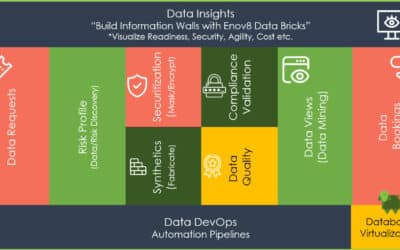
Enhancing Operational Resilience: Using DR Implementation Plans & Runsheets
AUG, 2023
by Jane Temov.
Jane Temov is an IT Environments Evangelist at Enov8, specializing in IT and Test Environment Management, Test Data Management, Data Security, Disaster Recovery, Release Management, Service Resilience, Configuration Management, DevOps, and Infrastructure/Cloud Migration. Jane is passionate about helping organizations optimize their IT environments for maximum efficiency.
In a world of advanced technology, ensuring uninterrupted stability remains a challenge. Establishing a robust disaster recovery strategy becomes imperative to mitigate the repercussions of unforeseen outages. This article delves into the significance of downtime costs, their underlying causes, and effective measures for swifter disaster recovery.
Enov8 IT & Test Environment Manager
*Innovate with Enov8
Streamlining delivery through effective transparency & control of your IT & Test Environments.
Understanding the Impact of Downtime
In today’s interconnected and technology-driven business landscape, the repercussions of downtime extend far beyond the immediate disruption. A comprehensive grasp of these consequences underscores the critical importance of implementing robust disaster recovery strategies. Here, we delve into the multifaceted impact of downtime:
Disruption of Productivity:
The seamless functioning of business operations hinges upon the availability of servers, cloud systems, and IT infrastructure. When unexpected outages occur, a ripple effect ensues, disrupting the regular flow of work. Employees are unable to access essential applications, collaborate effectively, or retrieve critical data. This disruption translates to impaired productivity across various departments, leading to both short-term setbacks and long-term delays in project timelines.
The consequences of reduced productivity extend beyond the immediate work downtime. Employees are forced to divert their attention from core tasks to deal with the aftermath of the outage, further delaying project completion and increasing the overall workload once systems are restored. This not only strains human resources but also accumulates hidden costs associated with inefficiency and delayed deliverables.
Reputation Damage:
The intangible but significant impact of downtime is on a company’s reputation. In sectors such as finance, where trust is paramount, outages can erode customer confidence and tarnish the brand’s credibility. This is especially true when sensitive data, financial transactions, or personal information are compromised due to the disruption.
Customer loyalty is fragile, and even a single instance of prolonged downtime can lead to customer attrition and negative word-of-mouth. Modern consumers demand seamless experiences and uninterrupted access to services, and any deviation from this expectation can result in lasting damage to the brand’s image. Restoring this trust can be a painstaking process, often requiring extensive resources to regain lost ground.
Revenue Erosion:
The financial impact of downtime reverberates throughout an organization’s balance sheet. Outages directly interrupt sales channels, impacting revenue generation. Whether it’s an e-commerce platform, online services, or customer-facing applications, the inability to transact during downtime translates to substantial revenue losses.
Moreover, the duration of an outage holds a direct correlation with the financial consequences. Even a short interruption can lead to missed opportunities and lost sales. Extended outages exacerbate these losses and can have far-reaching implications for the organization’s financial stability.
The implications of downtime-induced revenue erosion extend beyond immediate financial losses. Shareholders, investors, and stakeholders take note of a company’s ability to maintain consistent operations. Prolonged or recurring outages can shake investor confidence, leading to a drop in stock value and potentially triggering regulatory scrutiny.
Exploring the Root Causes of Outages
In the intricate ecosystem of modern technology, outages can stem from a diverse array of root causes. Understanding these underlying factors is crucial in developing targeted strategies to prevent and mitigate downtime. Here, we delve into the primary root causes of outages:
Human Error:
Despite technological advancements, human fallibility remains a significant factor in causing outages. Mistakes made during routine maintenance, updates, or configuration changes can inadvertently disrupt critical systems. Whether it’s misconfigured settings, improper handling of equipment, or accidental deletion of crucial data, these errors can have cascading effects on IT infrastructure and operations.
Human error underscores the importance of comprehensive training, meticulous documentation, and well-defined processes. Investing in continuous education and emphasizing the adherence to standard operating procedures can greatly reduce the risk of errors that lead to downtime.
Management Failures:
Effective management of IT infrastructure is essential for maintaining operational continuity. Management failures, such as inadequate monitoring, poor capacity planning, and insufficient resource allocation, can strain systems beyond their capabilities and trigger unexpected outages. These failures often result from a lack of visibility into system health, performance, and potential bottlenecks.
To mitigate management-related outages, organizations should adopt robust monitoring and management tools that provide real-time insights into system behavior. Proactive capacity planning, resource scaling, and regular system health assessments are imperative to identify and address vulnerabilities before they escalate into downtime.
Cyberattacks:
In an era where digital assets are under constant threat, cyberattacks pose a significant risk to IT environments. Malicious actors exploit vulnerabilities in software, networks, and applications to compromise systems, steal data, or disrupt services. Ransomware attacks, distributed denial-of-service (DDoS) attacks, and data breaches can all lead to extended periods of downtime.
To counter cyber threats, organizations must implement robust cybersecurity measures, including firewalls, intrusion detection systems, encryption, and regular security audits. A comprehensive incident response plan is vital to swiftly contain and recover from cyber incidents, minimizing downtime and data loss.
Power and Internet Outages:
The stability of IT operations relies heavily on a consistent power supply and reliable internet connectivity. Power outages, whether due to natural disasters, infrastructure failures, or maintenance issues, can instantly bring systems to a halt. Similarly, disruptions in internet connectivity can sever access to cloud services, data centers, and critical applications.
To address these vulnerabilities, organizations can implement redundant power systems, uninterruptible power supplies (UPS), and backup generators to ensure continuous operations during power outages. Diversifying internet connections through multiple service providers and leveraging failover mechanisms can help maintain online services even in the face of connectivity issues.
Factors Influencing Downtime Costs
Understanding the variables that impact downtime costs is essential for organizations to grasp the potential financial ramifications of disruptions. Downtime costs are influenced by a combination of factors that reflect the organization’s size, industry dynamics, timing of outages, and its unique business model. Here’s an in-depth look at these influential factors:
Organization Scale:
The scale of an organization plays a pivotal role in determining the financial impact of downtime. Smaller businesses, which often operate with tighter margins, can experience downtime costs averaging around $250 per minute. In contrast, larger enterprises, with more extensive operations and higher revenue streams, could face staggering costs exceeding $15,000 per minute.
Timing of Outages:
The timing of an outage significantly influences its financial repercussions. Outages during peak hours, such as business hours or times of high customer demand, can lead to more pronounced revenue losses. Conversely, disruptions during off-peak hours and less active months can mitigate financial losses, as fewer transactions are affected.
Industry Dynamics:
Different industries are exposed to varying degrees of vulnerability when it comes to downtime. Specialized sectors such as finance and healthcare, where real-time operations are critical, face heightened risks. On the other hand, industries like retail, education, and construction encounter downtime losses that, while still impactful, are comparatively milder due to different operational requirements.
Business Model Variance:
The nature of an organization’s business model also contributes to its susceptibility to downtime costs. Online businesses that rely heavily on digital platforms are more exposed to disruptions, as their operations are intricately tied to internet connectivity. Conversely, enterprises with physical establishments often possess more robust continuity plans and may have offline alternatives to maintain some level of operation during outages.
Calculating Downtime Costs
Accurately quantifying downtime costs requires a comprehensive understanding of the various elements that contribute to financial losses. By considering multiple dimensions, organizations can gain a holistic view of the impact and make informed decisions regarding disaster recovery investments. Here’s how downtime costs are typically calculated:
Revenue Downtime Cost:
The direct revenue loss due to downtime is calculated by multiplying the duration of downtime in minutes by the cost per minute. This metric reflects the immediate financial impact of interrupted operations.
Employee Downtime Cost:
Downtime affects not only revenue but also employee productivity. To assess this impact, calculate the affected employees’ number, multiplied by their productivity percentage, and then by their average hourly salary. This calculation considers the labor cost associated with unproductive time.
Downtime Cost per Hour:
A more comprehensive metric combines revenue loss, employee productivity loss, recovery expenses, and intangible costs. This provides a more nuanced understanding of the true financial impact of downtime on the organization’s bottom line.
Mitigating Costs & Impacts
To proactively minimize downtime costs and their associated impacts, organizations, supported by Disaster Recovery Managers, can adopt a strategic approach that integrates key best practices. Incorporating these practices can significantly enhance the resilience of business operations during unforeseen disruptions. Here are some recommended strategies:
Comprehensive Disaster Recovery (DR) Plan with Implementation or Cutover Plans:
Developing a well-structured DR plan is the foundation of effective disaster recovery. Collaborate with IT recovery experts to not only formulate a comprehensive DR plan but also include detailed Implementation or Cutover Plans. These plans outline the step-by-step process to transition from normal operations to the recovery state. They provide clear guidelines on how to bring systems and applications back online, reducing ambiguity and speeding up the recovery process.
Utilizing Standardized Operating Procedures (Runsheets):
Standardized Operating Procedures, often referred to as Runsheets, play a crucial role in disaster recovery. These documents outline predefined sequences of actions required to perform specific tasks accurately and consistently. By leveraging well-tested Runsheets, your recovery team can follow established protocols, reducing the risk of errors that can lead to extended downtime. These procedures can be continuously refined based on real-world experiences, making them a valuable asset for streamlined recovery operations.
Integration of Orchestration and Automation:
Orchestration and automation technologies offer a powerful means to streamline recovery tasks and minimize manual intervention. By automating routine processes and orchestrating the execution of complex recovery procedures, you can significantly reduce the chance of human errors and accelerate recovery times. Automation ensures tasks are performed consistently and rapidly, allowing your team to focus on critical decision-making rather than manual execution.
Training and Skill Development:
Equip your recovery team with the necessary skills to execute the DR plan effectively. Comprehensive training programs should cover various scenarios, use of Runsheets, and the utilization of orchestration tools. Regular drills and simulated recovery exercises can help your team become familiar with the procedures, identify potential bottlenecks, and fine-tune the process for optimal results.
Continuous Testing and Improvement:
Regularly test your disaster recovery plans in controlled environments to identify potential weaknesses and areas for improvement. These tests should include end-to-end scenarios, testing the implementation of Runsheets, and assessing the efficiency of automation processes. Based on test results, refine your plans, procedures, and automation scripts to enhance their effectiveness and accuracy.
Collaboration and Communication:
Establish efficient communication channels across all stakeholders involved in the recovery process. Clear communication ensures that everyone understands their roles and responsibilities during a disaster. Regular updates, status reports, and post-recovery reviews contribute to a culture of continuous improvement and better preparedness for future incidents.
By embracing these best practices, organizations can bolster their disaster recovery capabilities and minimize the impact of downtime. Implementation or Cutover Plans, standardized Runsheets, and the strategic use of orchestration and automation collectively enhance operational resilience and position businesses for a swift and effective recovery from unexpected outages.
Enhancing Disaster Recovery Implementation with Enov8
Enov8 excels in enhancing disaster recovery capabilities by offering a key capability: the ability to construct robust Disaster Recovery Plans, Implementation Plans, and Runsheets that encompass both manual and automated tasks. This unique capability not only facilitates a deeper understanding of recovery processes but also streamlines the execution of recovery events.
Enov8’s approach bridges the gap between theory and practice, ensuring that disaster recovery plans are not just theoretical documents but actionable guides. By integrating both manual and automated tasks, Enov8 empowers organizations to respond swiftly and effectively during crises, significantly improving the outcome of recovery efforts.
Conclusion
In the realm of modern business operations, the inevitability of outages underscores the critical importance of proactive preparation and strategic responsiveness. By delving into the root causes and understanding the multi-dimensional costs of downtime, organizations can pave the way for a more resilient future.
Implementing a comprehensive disaster recovery plan stands as a cornerstone of effective resilience. This plan not only mitigates the impact of disasters but also instills confidence among stakeholders that the organization is well-prepared to navigate challenges.
For those seeking a comprehensive solution to bolster their disaster recovery capabilities, Enov8’s IT Environment & Release Management Suite emerges as a valuable resource. This suite offers a comprehensive framework to not only practice and refine disaster recovery events but also execute them efficiently. By leveraging Enov8’s suite, businesses can ensure rapid recovery even in the face of unexpected outages, safeguarding their operations and reputation.
Relevant Articles
8 DevOps Anti-Patterns to Avoid
It’s the normal case with software buzzwords that people focus so much on what something is that they forget what it is not. DevOps is no exception. To truly embrace DevOps and cherish what it is, it’s important to comprehend what it isn’t. A plethora...
An Introduction to Application Rationalization
In today's fast-paced digital landscape, organizations often find themselves grappling with a sprawling array of applications. While these applications are crucial for various business operations, the lack of a structured approach to managing them can lead to...
What Makes a Great Test Data Management Tool
What Makes a Great Test Data Management Tool? In today's fast-paced IT landscape, having a robust Test Data Management (TDM) tool is crucial for ensuring quality, compliance, and efficiency in software development and testing. At Enov8, we pride ourselves on providing...
The Top Application Portfolio Management Tools
Managing an application portfolio is essential for organizations aiming to optimize their IT operations, reduce costs, and enhance overall efficiency. Application Portfolio Management (APM) tools are designed to help organizations achieve these goals by providing a...
What Is a Test Data Manager?
Testing is a critical aspect of software development, and it requires the use of appropriate test data to ensure that the software performs optimally. Test data management (TDM) is the process of creating, storing, and managing test data to ensure its quality,...
Sprint Scheduling: A Guide to Your Agile Calendar
Agile sprints can be a powerful, productive and collaborative event if managed properly. However, when neglected or set up incorrectly they risk becoming chaotic and inefficient. Crafting an effective schedule for your sprint is essential to ensure the success of your...










